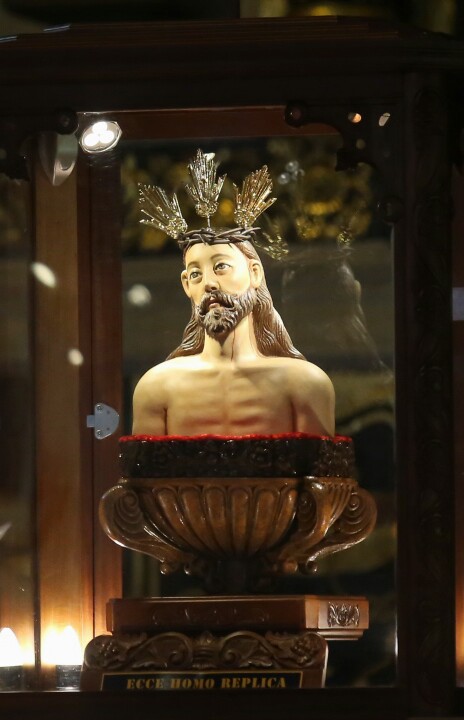
The original image of the Ecce Homo given by Portuguese explorer Ferdinand Magellan is venerated inside the centuries-old Basilica del Sto. Nino in Cebu City.(CDN PHOTO/Junjie Mendoza)
It is not as popular as the Sto. Niño de Cebu.
But the four century-old bust of the suffering Jesus Christ known as the “Ecce Homo” is an equally significant religious icon that has become a part of the country’s heritage.
“The Ecce Homo is important in our history as a Church and nation. By and large, this is the Philippines’ second oldest image next to the Sto. Niño,” said Fr. Ric Anthony Reyes of the Augustinian friars to whom the two ancient images were entrusted.
Cebuanos on Saturday celebrated the feast of the Ecce Homo, an icon given as the baptismal gift by Portuguese explorer Ferdinand Magellan to Cebu’s Rajah Humabon in 1521.
Fr. Pacifico “Jun” Nohara, rector of the Basilica Minore del Sto. Niño, presided over the 8 a.m. fiesta Mass inside the centuries-old church in downtown Cebu City to commemorate the finding of the Ecce Homo together with the human remains believed to be that of Rajah Humabon on Aug. 20, 1572.
The Augustinians moved the feast a day earlier since August 20 this year falls on a Sunday which cannot be impeded by any other celebrations.
(CDN PHOTO/Junjie Mendoza)
“Ecce Homo” is Latin for “Behold the Man,” the words spoken by Roman official Pontius Pilate when he presented Jesus before the crowd.
Reyes, who was tasked to give the homily, explained the connection between the Ecce Homo and the Sto. Niño.
“The Ecce Homo completes our devotion to the Sto. Niño. If through the Sto. Niño, we contemplate the childhood of Jesus, the Ecce Homo remind us that Christ grew up and suffered for our sake,” he said.
Reyes called the people to ponder upon Jesus’ sufferings and to remain hopeful in the face of adversities.
“As a country, we are confronted with problems like war, illegal drugs, and poverty. We see ourselves in the suffering Christ. And so let us unite our sufferings with that of Jesus,” he said.
“But as we contemplate on Jesus, let us see him not with suffering, blood, and death but with hope. The Christ who suffered for us also rose for us. Let us be united in hope with Jesus,” he added.
In historical accounts, the Ecce Homo was presented to Cebu’s chieftain King Humabon who was known as “Carlos” after his baptism.
Magellan also gave the image of the Sto. Niño to Cebu’s Queen Juana, while the natives got a small image of the Blessed Virgin Mary.
The image of the Ecce Homo was found in Cebu on Aug. 20, 1572, the same day that Miguel Lopez de Legaspi died in Manila. The ivory bust was found on the chest of a rajah believed to be Humabon.
Augustinians brought the image to the San Agustin Church in Intramuros, Manila during the Fourth Centennial Celebration of the Christianization of the Philippines in 1965.
Since then, only a replica of the image was found in Cebu.
The Cebu Archdiocese through Archbishop Emeritus Ricardo Cardinal Vidal worked for the return of the valuable image to Cebu.
The request was granted by the Augustinian friars in Manila and the historical icon was brought back to the Queen City of the South in 2011.